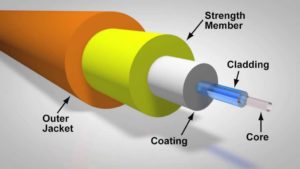As the first defense line against the surrounding environment, the cable jacket prevents the core of fiber optic cable from water, flame, chemistry, etc. Meanwhile, the outermost layer keeps inert to gases and liquids that may be exposed during its service life. Besides, the cable jacket provides a smooth, low friction surface. The jacket must be made of a material that can keep the cable flexibility and maintainability at all temperatures during its service life. Today our topic is the cable jacket rating of fiber optic cable.
What Is Cable Jacket?
The optical fiber cable is composed of the inner core, cladding, coating, strength member and the outer cable jacket. The core made of plastic or glass is a physical medium used for optical signal transmission. Because bare fibers are easily broken, outer cable jacket is required to protect optical fibers. Just like mentioned above, the cable jacket is the first line of moisture, mechanical, flame and chemical protection for cables. If there is no jacket, fiber optic cable is likely to be damaged during and after installation. Common jacket materials are PE (Polyethylene), PVC (Polyvinyl Chloride) and LSZH (Low Smoke Zero Halogen).

Fiber Cable Structure
Cable Jacket Rating of Fiber Optic Cable
In general, the NEC (National Electrical Code) provides eight grades of fire resistance for non-conductive and conductive cables. All indoor cables must be marked and installed for the intended purpose: plenums, risers, and general purpose areas.
- Plenums: A plenum area is is used for air flow or air distribution system (ceiling and elevated floor) building space.
- Risers: A riser area is a floor opening, shaft or pipe vertically passing through one or more floors.
- General purpose areas: The general area refers to all other areas on the same floor without pressure ventilation systems or risers.
Cable jacket rating is important. If the cables do not have these ratings, they cannot be installed on walls or ceilings. Here we will introduce the most common cable jacket ratings that you will encounter.
- CL/CM/CMG: These cable jackets are applicable to all common situations. Specifically, CL cables are used for audio and video applications, and CM/CMG for communication applications, such as Ethernet. They are all tested through the so-called “vertical tray flame test”, which means they usually won’t spread the flame more than eight feet. You can install these rated cables on walls or ceilings without worrying about risers and plenums at home.
- CMR: The CMR rating means that the cables can be used in the risers of commercial buildings because they limit flame spread better than the cables in the CL/CM series. In addition to plenums, they can be installed anywhere.
- CMP: “P” clearly represents the plenum, so in addition to the places where CM and CMR cables can operate, this communication cable can also be used for plenums. The jacket is made of the material that retards the spread of flame. It does not emit a large amount of smoke or poisonous gas when it burns.
Conclusion
These are the common ratings of fiber optic cable jacket. We should follow these cable jacket ratings in the NEC guidelines to minimize the risk of impact, fire and toxic smoke in each area, thus preventing fire. Besides, fiber optic cable plays an important role in the field of communication. You can visit www.fs.com to find fiber cables that can meet your needs, such as single mode fiber optic cable, multimode fiber optic cable, and fiber patch cord. I hope you can get your own cable.